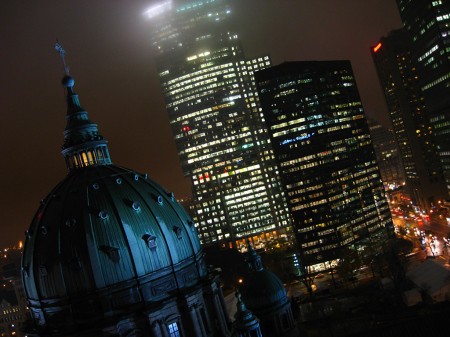Alongside general jubilation about the Obama victory, a number of my friends have expressed their concern about Obama’s personal safety. That certainly seems like a legitimate concern. Four American presidents have been assassinated while in office, and every president since Nixon has faced at least one attempt (though levels of credibility vary). During his victory speech on election night, most people probably noticed the transparent bulletproof barriers set up around the podium.
The Secret Service is certainly taking the threat seriously. According to a Stratfor briefing, Obama got a security detail earlier than any other candidate and, by the end of his campaign, it had grown to the size of a full presidential protection team – unprecedented for a candidate, and a significant strain on the manpower of the service.
Given the likelihood that Obama will be targeted by white supremacists or others – as well as the colossal impact his assassination would likely have – I certainly don’t envy the Secret Service at this point in time. While they have plenty of resources to provide physical protection, as well as identify and break up conspiracies, the risk from disciplined and capable lone wolf operators is impossible to eliminate while maintaining public appearances. Even with the assistance of the FBI, CIA, NSA, etc, there will be a measure of luck involved in ensuring that future close contact with the public does not produce disaster.


Milan,
An unfortunate aspect of the age we live in is that the mere fact of mentioning this possibility online is probably enough to attract the notice of big brother.
Hey,
Where are my pics from election night? Were they too unflattering to post?
Chris,
There is a decent chance that almost everything we do online passes through some kind of automated scanning system run by an intelligence agency. Such is the nature of modern life in North America.
Ashley,
I am in Montreal visiting my brother, who is in the hospital following an appendectomy. I don’t have access to my main computer, and probably won’t be uploading photos until I return to Ottawa on Tuesday.
Building a bubble-top bulletproof ObamaMobile should clearly be a priority.
For the sake of global security, I hope the US Secret Service succeeds for as long as Obama is in office.
Protecting Obama
By Davi Ottenheimer on Security
Executive Protection News is a great source for details on protecting the President Elect of America:
When Obama gave his victory speech in Chicago’s Grant Park, the level of security was described as “unprecedented” although I think “Presidential level” is probably more appropriate. Among the measures in place was a ballastic glass shield surrounding the podium, the entire Chicago Police force of 13,500 (although clearly not just to protect Obama) was on duty, a no-fly zone was established over the city, and all off-duty firemen went home with their gear in the event they had to return to duty. The total cost for security that evening was reported as $2 million USD although much to their credit, the Obama campaign will reimburse Chicago for the costs (I’ve been advocating that the political parties pay for convention security since this election started). These measures were appropriate in light of the arrest the week before the election of two white supremacists who alledgedly were planning to assassinate Obama.
Fein, Robert and Bryan Vossekuil. ”Assasination in the United States: An Operational Study of Recent Assassins, Attackers, and Near-Lethal Approachers.” Journal of Forensic Sciences, March 1999.
The Challenges of Protecting High-Value Targets in a Crowd
July 28, 2006
Crowd situations are among the most difficult for personal protection details to control because an attacker can appear suddenly from anywhere. In these situations, security details know only after the fact whether the assailant intended a lethal strike or was just trying to make a point. Defending against an assailant wielding pepper spray involves many of the same considerations as defending against a knife- or gun-wielding assassin. The key is to spot the attacker before he can strike by observing any erratic or suspicious behavior, and to move in before the attack occurs.
Many world leaders have been assassinated by attackers coming out of presumably friendly crowds at public events. Former Indian Prime Minister Rajiv Ghandi died in 1991 after a female suicide bomber approached him carrying a bomb concealed in a basket of flowers. Israeli Prime Minister Yitzhak Rabin also died at the hands of an attacker in a crowd. U.S. Presidents William McKinley and Ronald Reagan were shot as well — McKinley lethally — by attackers coming out of crowds. Gerald Ford was shot at but not hit in a similar incident.
Politicians, world leaders and others sometimes are physically attacked by protesters who do not intend to cause physical harm, but rather to draw attention to their causes and embarrass their targets. In November 2000, an environmental activist hit Frank Loy, chief negotiator for the U.S. delegation at climate change talks in the Netherlands, in the face with a cream pie. The same month, an anti-war protester at the German Green Party Congress threw paint on German Foreign Minister Joschka Fischer. In June 2001, Enron executive Jeffrey Skilling was hit by a pie thrown by a protester as he entered the Commonwealth Club in San Francisco. In August 2001, an activist hit Canadian Prime Minister Jean Chretien in the face with a cream pie. In May 2004, an activist threw a condom at British Prime Minister Tony Blair as he addressed the House of Commons, prompting a security review at the British Parliament. Each of these incidents represents a breach in security that allowed the assailants to get close enough to the targets to potentially do serious, possibly lethal, harm.
In ‘Zero Fail,’ Carol Leonnig Says Secret Service Is Underfunded And Overworked : NPR
https://www.npr.org/2021/05/17/997377737/underfunded-and-overworked-secret-service-fears-theyre-relying-on-luck